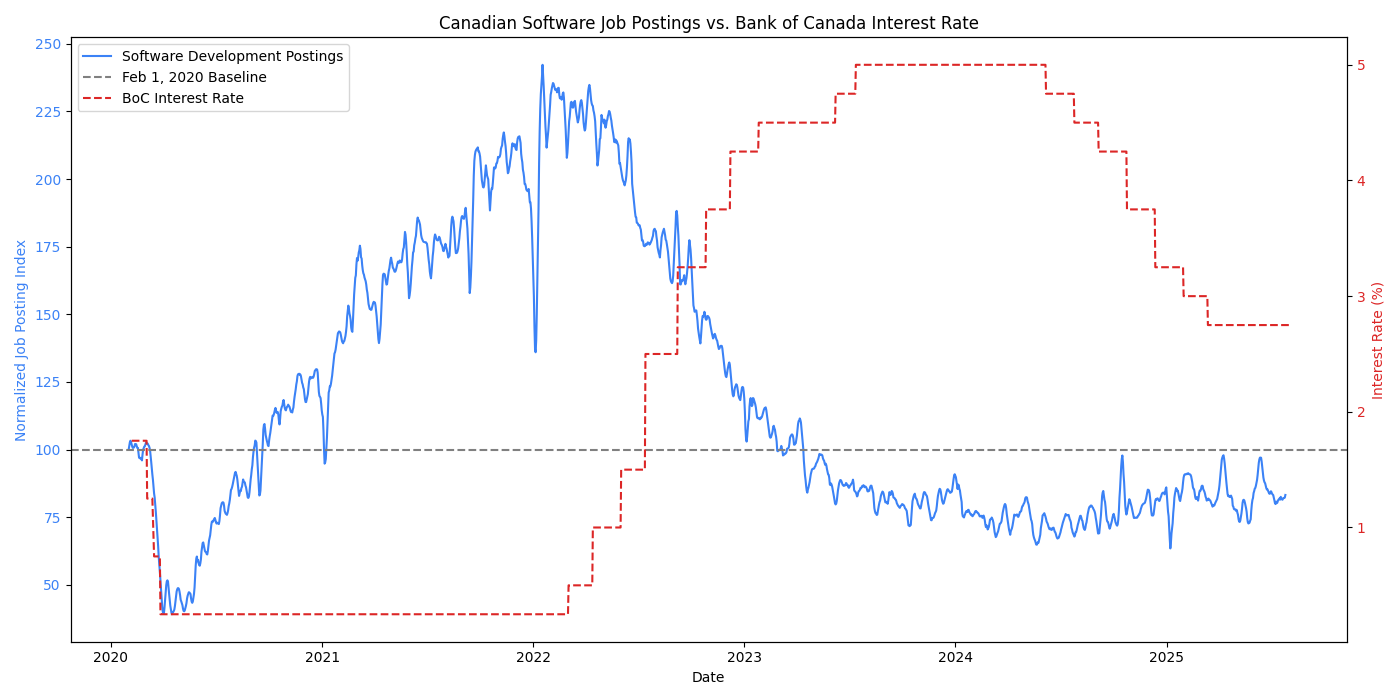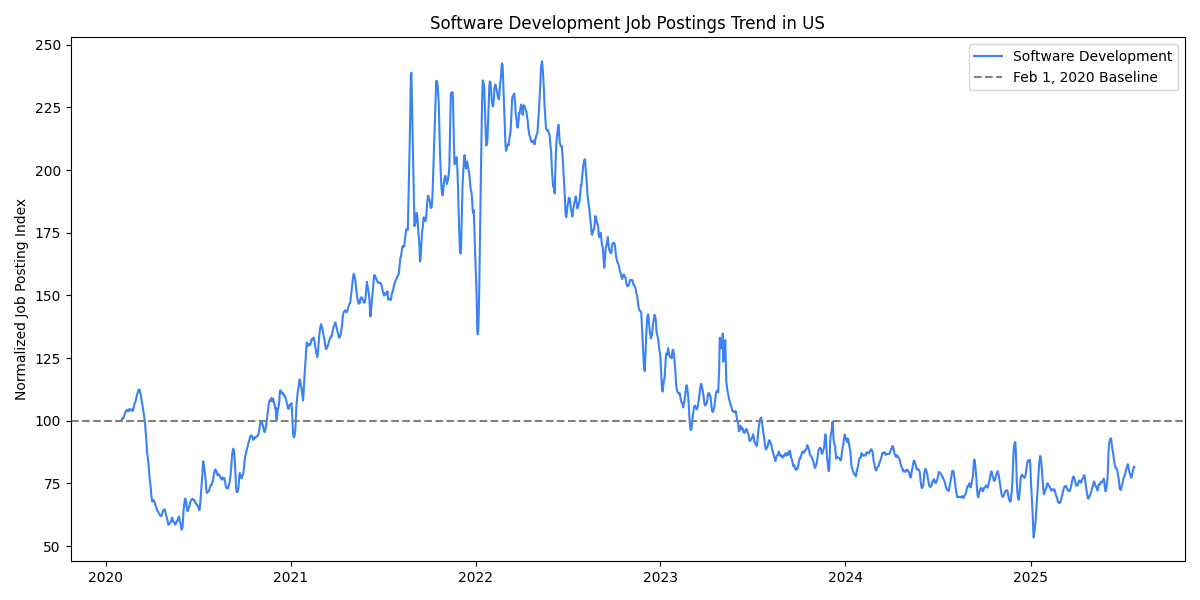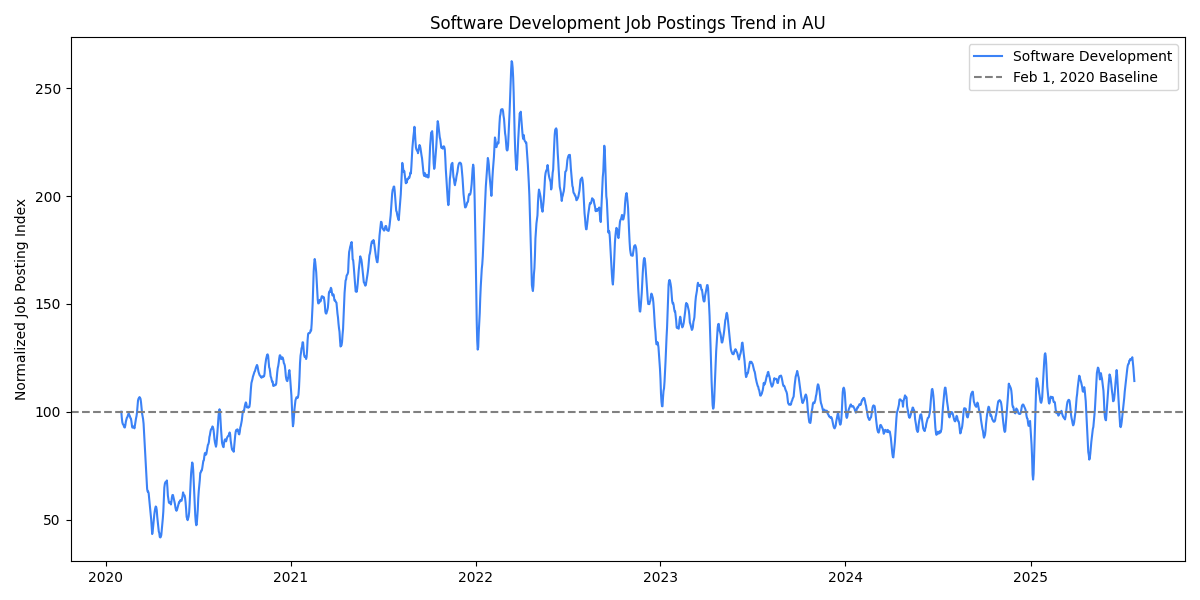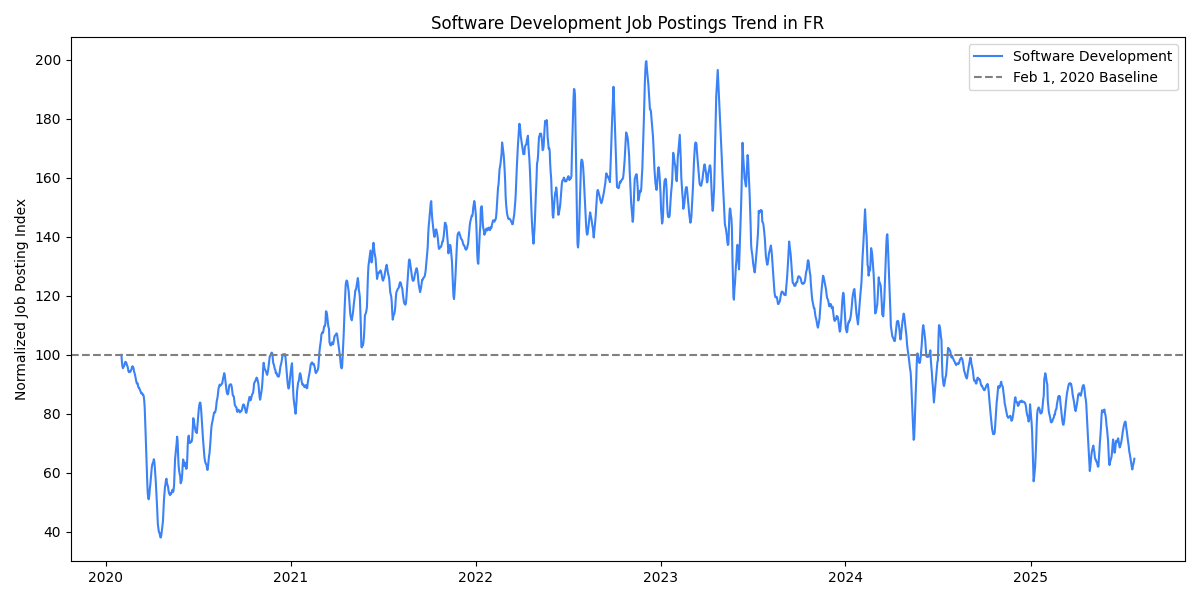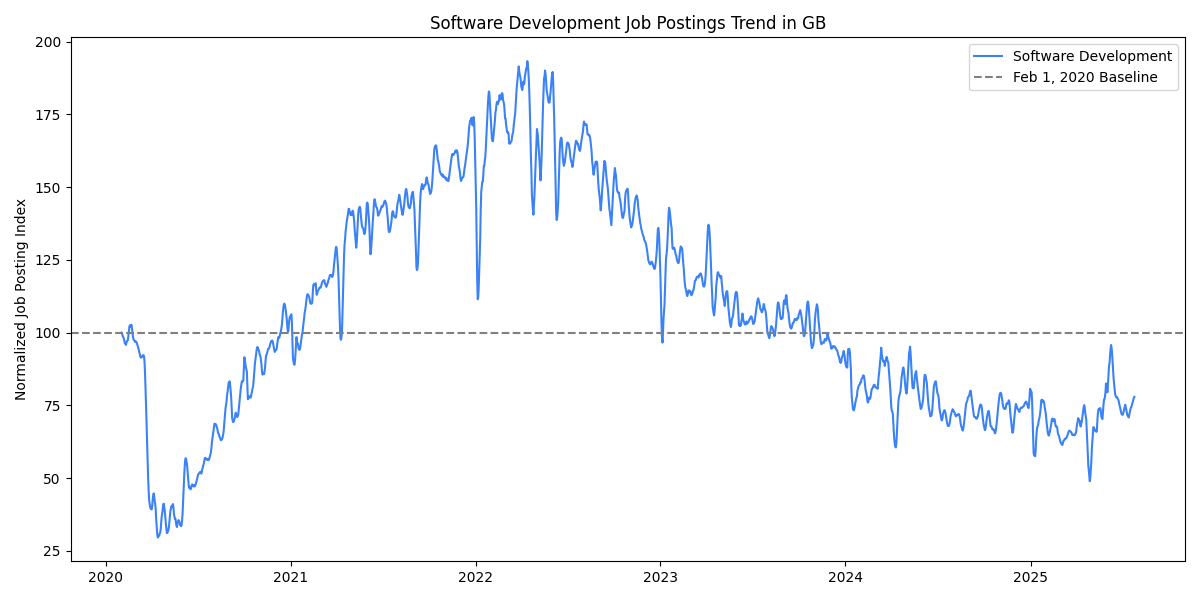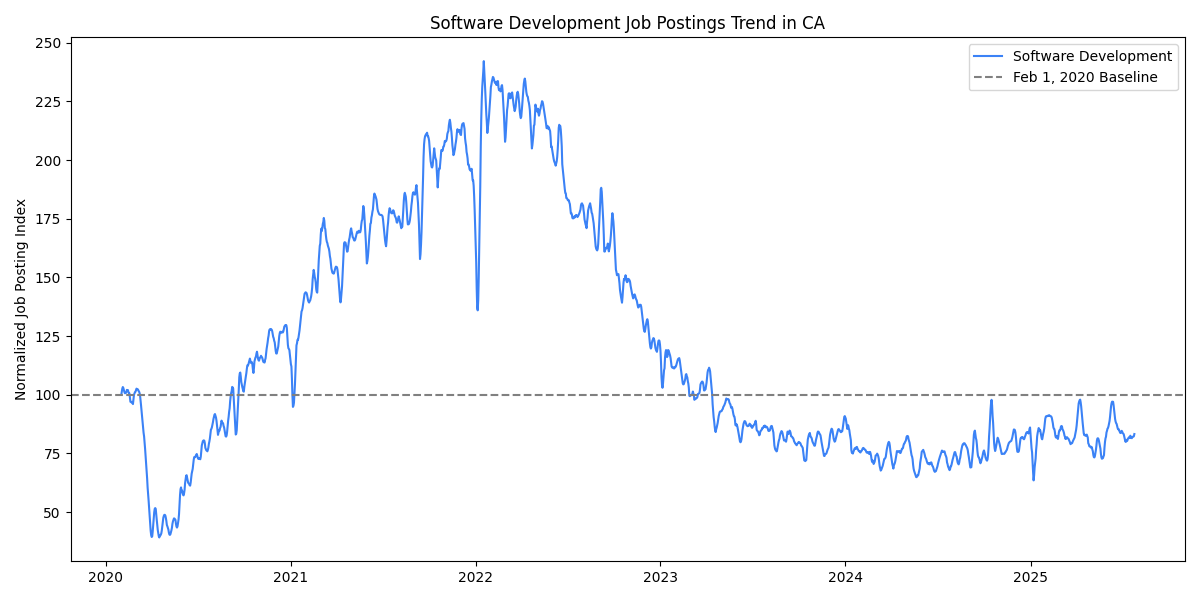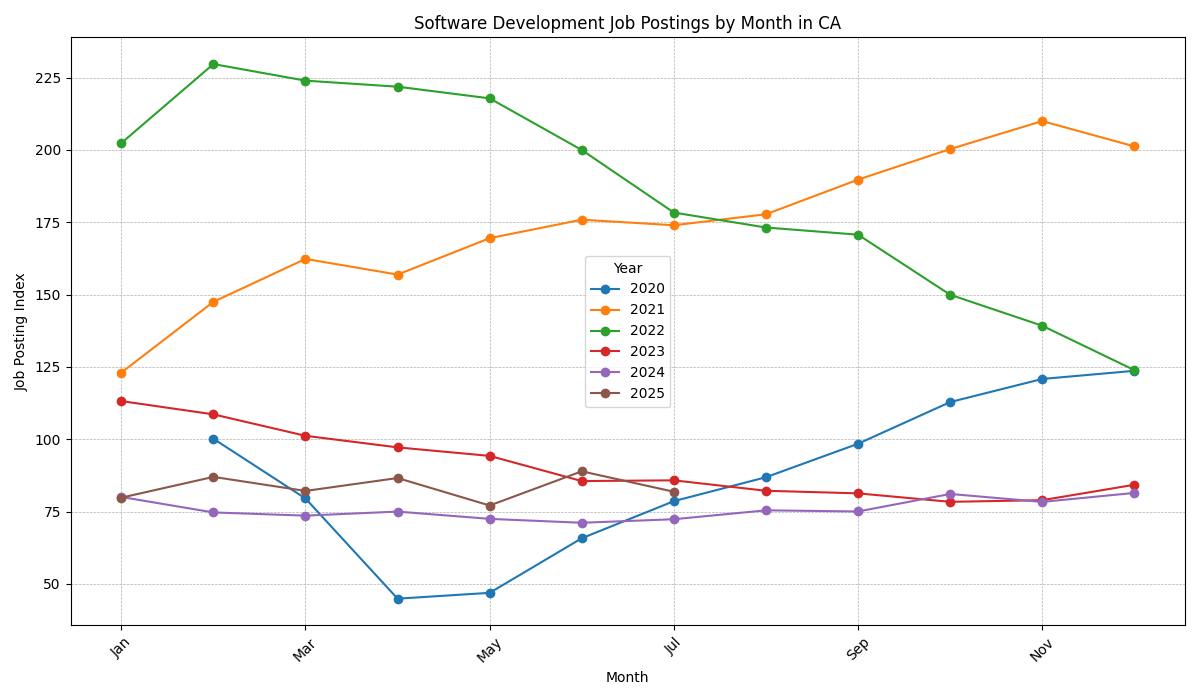Is the Golden Age for Software Developers Over? What 5 Years of Job Data Reveals
An analysis of recent job posting data to understand the trends shaping the software developer job market and strategies for early-career developers.
The Developer Job Market
As a developer navigating this market, I wanted to move beyond the headlines and understand the trends shaping our industry. This post explores three key questions using five years of hiring data (February 2020 - July 2025):
- What is the current state of the software developer job market? We’ll analyze job posting trends to see where we stand after the post-pandemic boom.
- Is there a “hiring season” to aim for? We’ll examine the data for seasonality to see if timing your applications makes a difference.
- What can we do to succeed? We’ll outline practical strategies for navigating a competitive environment.
A Five-Year Trend of the Job Market
To understand where the industry stands, we’ll analyze job posting data from Indeed’s Hiring Lab and interest rate data from the Bank of Canada, focusing on the period from February 2020 to July 2025.
The Big Picture: The Post-Pandemic Boom and Bust
A statistical analysis of the data reveals a moderate negative correlation (r = -0.55) between the Bank of Canada’s interest rate and software development job postings during this period.
While this statistical correlation is evident, it’s important to note that correlation does not imply causation. It’s plausible that other industry-specific factors, such as the pandemic-era hiring surge, shifts in venture capital funding, and the recent focus on AI, have also contributed to this trend. However, the visual alignment is striking:
- The Boom (2020-2022): During the period of near-zero interest rates, software development job postings surged, indicating a period of rapid growth in the tech sector.
- The Cooldown (2022-Present): As the Bank of Canada began to raise interest rates, job postings declined significantly. Interestingly, the recent stabilization and slight decrease in interest rates in 2024 and 2025 have not yet triggered a corresponding boom in hiring, suggesting there may be a lag effect or other economic factors at play.
From personal experience, many say that AI and high-interest-rate environments helped to build leaner teams. This is due to the potential for increased productivity that AI brings to developer workflows. For example, if you are building a common feature like a dashboard, a coding tool like Gemini-CLI or the ever-evolving tunacode can dramatically speed up the process. There are tons of approaches to avoid re-solving old problems, which brings immense efficiency to a business.
Perhaps the next data analysis should measure the correlation between tech job postings and the adoption of AI developer tools; it might be as revealing as the interest rate correlation.
A Global Phenomenon
This trend is not unique to Canada. Similar patterns of a post-2022 cooldown in software development hiring are visible in the data globally, pointing to the influence of global macroeconomic factors rather than local market issues.
Does Seasonality Matter in the Current Market?
I wondered if it is true that Hiring picks up during September to October.
This chart shows the monthly trend for Canadian software development job postings from 2020 to 2024. Here’s what it reveals:
- No Consistent Seasonal Pattern: While a fall hiring surge was visible during the 2020-2021 boom, this pattern completely inverted during the 2022-2023 cooldown. In 2024, the trend was mostly flat, showing no strong seasonal signal.
- Macro Trends Overwhelm Seasonality: The data strongly suggests that any underlying seasonal effects are minor compared to the impact of the broader economic cycle. The market’s overall contraction or expansion is a primary driver of hiring opportunities.
The key takeaway is that job seekers should focus on being consistently prepared and active, rather than trying to time their job search to a specific season that may or may not materialize.
From Analysis to Action: A Developer’s Strategy
The data confirms what many developers are feeling: the market isn’t just tight, it’s contracting. Standard advice like “network more” can feel hollow when job postings are scarce. For career-switchers, recent graduates, or anyone trying to land a first role, the reality can be brutal. Searching for an “entry-level developer” position can yield dozens of irrelevant results, with many demanding years of experience for a junior role.
When faced with this reality, what can we do? The most effective path forward is to shift focus from passively applying for jobs to actively building undeniable proof of skill. If applying feels like sending requests to a dead API, it’s time to build your own endpoint. This strategy boils down to two key initiatives:
Contribute to Open Source: Find an open-source project that interests you. Contributing gives you practical experience, exposure to different technologies, and the opportunity to collaborate with other developers. For example, I recently resolved an issue for tunacode, which was similar to my ruby gem. This allowed me to read others’ code and integrate a new feature in a Python environment; a first for me. That single contribution expanded my experience with AI integration and familiarized me with a new codebase, opening doors to future contributions or other projects.
Build Your Own Thing: Be a builder. Create your own SaaS application from the ground up. Focus on delivering a Minimum Viable Product (MVP) without getting bogged down by feature creep. Use the project as a learning opportunity, a way to attract real users, and potentially even generate revenue. With modern AI tooling, building features that once took days can now be done in hours, making it easier than ever to launch your own products.
So while the market tries to find its footing, we can work to become better developers and focus on what we can control: our skills and our creations.
Conclusion
The data reveals a software development job market that has undergone a significant contraction since the boom of 2020-2021, driven by macroeconomic shifts and the industry wide adoption of AI. For early-career developers, this new landscape doesn’t just demand a polished resume; it demands undeniable proof of skill. The hard truth is that in a market this competitive, standing out isn’t just an advantage; it’s a prerequisite for survival. Focusing on tangible accomplishments through open source and personal projects is no longer optional; it’s the most pragmatic strategy for building a career that can weather this storm.
Credits and Further Reading
- Orosz, Gergely. The Pragmatic Engineer Blog. Advice for Less Experienced Software Engineers in the Current Tech Market.
- Indeed Hiring Lab. Job Postings Tracker.
- Bank of Canada. Canadian interest rates and monetary policy variables: 10-year lookup
